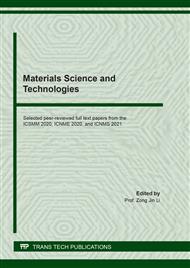[1]
S. Iqbal, et al., Silver nanoparticles stabilized in polymer hydrogels for catalytic degradation of azo dyes,, Ecotoxicol. Environ. Saf. 202 (2020) 110924.
DOI: 10.1016/j.ecoenv.2020.110924
Google Scholar
[2]
C. Wang, et al., Metal–organic frameworks and their derived materials: Emerging catalysts for a sulfate radicals‐based advanced oxidation process in water purification,, Small 15(16) (2019) 1900744.
DOI: 10.1002/smll.201900744
Google Scholar
[3]
V.K. Sharma, M. Feng, Water depollution using metal-organic frameworks-catalyzed advanced oxidation processes: a review,, J. Hazard. Mater. 372 (2019) 3-16.
DOI: 10.1016/j.jhazmat.2017.09.043
Google Scholar
[4]
N. Wang, T. Zheng, G. Zhang, P. Wang, A review on Fenton-like processes for organic wastewater treatment,, J. Environ. Chem. Eng. 4(1) (2016) 762-787.
Google Scholar
[5]
A. Wibowo, et al., Simple preparation of Fenton catalyst@ bacterial cellulose for waste water treatment,, Mater. Res. Express. 5(2) (2018) 024005.
DOI: 10.1088/2053-1591/aaac86
Google Scholar
[6]
A. Babuponnusami, K. Muthukumar, A review on Fenton and improvements to the Fenton process for wastewater treatment,, J. Environ. Chem. Eng. 2(1) (2014) 557-572.
DOI: 10.1016/j.jece.2013.10.011
Google Scholar
[7]
M.A. Marsudi, et al., Manganese Oxide Nanorods Decorated Table Sugar Derived Carbon as Efficient Bifunctional Catalyst in Rechargeable Zn-Air Batteries,, Catalysts 10(1) (2020) 64.
DOI: 10.3390/catal10010064
Google Scholar
[8]
J.-Y. Chen, C.-Y. Yang, P.-Y. Chen, Synthesis of hierarchically porous structured CaCO3 and TiO2 replicas by sol-gel method using lotus root as template,, Mater. Sci. Eng. C 67 (2016) 85-97.
DOI: 10.1016/j.msec.2016.04.092
Google Scholar
[9]
P. Phatai, C. Futalan, S. Kamonwannasit, P. Khemthong, Structural characterization and antibacterial activity of hydroxyapatite synthesized via sol-gel method using glutinous rice as a template,, J Solgel Sci Technol 89(3) (2019) 764-775.
DOI: 10.1007/s10971-018-4910-9
Google Scholar
[10]
W. Zhang, et al., Facile fabrication of flexible magnetic nanohybrid membrane with amphiphobic surface based on bacterial cellulose,, Carbohydr. Polym. 86(4) (2011) 1760-1767.
DOI: 10.1016/j.carbpol.2011.07.015
Google Scholar
[11]
A.K. Gupta, M. Gupta, Synthesis and surface engineering of iron oxide nanoparticles for biomedical applications,, biomaterials 26(18) (2005) 3995-4021.
DOI: 10.1016/j.biomaterials.2004.10.012
Google Scholar
[12]
A. Ruíz-Baltazar, R. Esparza, G. Rosas, R. Pérez, Effect of the surfactant on the growth and oxidation of iron nanoparticles,, J. Nanomater. 2015 (2015).
DOI: 10.1155/2015/240948
Google Scholar
[13]
R. Wahab, F. Khan, A.A. Al-Khedhairy, Hematite iron oxide nanoparticles: apoptosis of myoblast cancer cells and their arithmetical assessment,, RSC Adv. 8(44) (2018) 24750-24759.
DOI: 10.1039/c8ra02613k
Google Scholar
[14]
W. Wu, Q. He, C. Jiang, Magnetic iron oxide nanoparticles: synthesis and surface functionalization strategies,, Nanoscale Res. Lett. 3(11) (2008) 397.
DOI: 10.1007/s11671-008-9174-9
Google Scholar
[15]
M. Baalousha, Aggregation and disaggregation of iron oxide nanoparticles: influence of particle concentration, pH and natural organic matter,, Sci. Total Environ. 407(6) (2009) 2093-2101.
DOI: 10.1016/j.scitotenv.2008.11.022
Google Scholar
[16]
N. Zhu, et al., Surface modification of magnetic iron oxide nanoparticles,, Nanomaterials 8(10) (2018) 810.
Google Scholar



